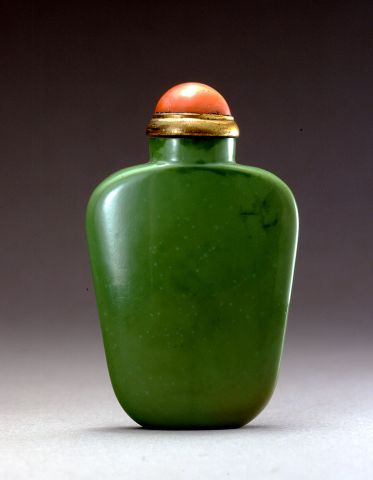
Bottle ID: 282
SHIELD SHAPE
Date: 18th century
Height: 54 mm
Turquoise, well patinated, of flattened rectangular form tapering to the concave oval foot, and with rounded shoulders.
Possibly imperial, attributed to the Palace Workshops.
Similar Examples:
Hall, Robert. Chinese Snuff Bottles II, 1989, p. 49, no. 34.
Kleiner, Robert W. L. Chinese Snuff Bottles from the Collection of John Ault, 1990, p. 77, no. 131.
White, Helen. Snuff Bottles from China: The Victoria and Albert Museum Collection, 1990, pp. 116-117, no. 2.
Stevens, Bob C. The Collector's Book of Snuff Bottles, 1976, p. 165, no. 601.
Provenance:
Clare Lawrence Ltd.
Alexander Brody
Joseph Baruch Silver
Exhibited:
Honolulu Academy of Arts, Honolulu, Hawaii, November 23, 1989 - January 7, 1990
Israel Museum, Jerusalem, Israel, December 15, 1987 - June 25, 1988
Published:
Lawrence, Clare. The Alexander Brody Collection of Chinese Snuff Bottles, 1995, p. 35. no. 49
Chinese Snuffbottles from the Collection of Joseph Baruch Silver in Conjunction with the Exhibition at The Israel Museum, Jerusalem, Winter 1987, p. 24, no. 35
The turquoise used to produce snuff bottles in the 18th and 19th centuries is likely to have been imported from Tibet, although it was also prolifically mined in Persia, by the Egyptians in the Sinai Peninsula and in Russia. Its inherent value to Tibetans was such that they attempted to keep the whereabouts of the mines a secret. China also had some turquoise mines in Hubei Province and Xinjiang Province, so it is possible that bottles could have been produced from mines there. The Qianlong emperor conquered this area in 1759 and would have had unfettered access to the mines from this point. The Tibetans were not the only people to value turquoise, it became part of Qing Court rituals with the Qianlong Emperor wearing a necklace of turquoise for ceremonies at the Altar of the Moon. In the list of tributes sent up from Guangdong to the Qing Court appears a turquoise mountain in the 59th year of Qianlong. Without a doubt some of the turquoise bottles in collections today started their lives at the imperial court, but it is hard to identify those examples. Like present day snuff bottle collectors, the Mongolians, who used turquoise and coral extensively for decorative purposes, preferred a more greenish tone in the stone, whilst jewelers prefer a sky-blue tone with little black veining. The Crane bottle is of a green color with a very smooth, well patinated and thus appealing tactile surface. It is possible that this 18th century group with so little veining came from a different mine than the slightly later group, although at present there is no way in which to differentiate between the two types of stone. Late Ming to early Qing works of art exist where the stone is hardly veined. The less veined a turquoise bottle is, the more likely it is to be reasonably hollowed, although this does not particularly give an indication of date since a bottle with a strong matrix would have to be less hollowed as it is more brittle.
< Back to full list
 English
English 中文
中文